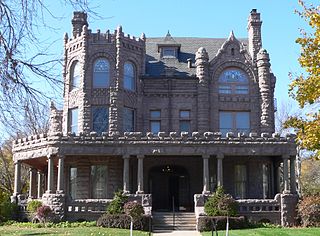
Effigy Mounds National Monument preserves more than 200 prehistoric mounds built by pre-Columbian Mound Builder cultures, mostly in the first millennium CE, during the later part of the Woodland period of pre-Columbian North America. Numerous effigy mounds are shaped like animals, including bears and birds.

The Field Museum of Natural History (FMNH), also known as The Field Museum, is a natural history museum in Chicago, Illinois, and is one of the largest such museums in the world. The museum is popular for the size and quality of its educational and scientific programs, and its extensive scientific specimen and artifact collections. The permanent exhibitions, which attract up to 2 million visitors annually, include fossils, current cultures from around the world, and interactive programming demonstrating today's urgent conservation needs. The museum is named in honor of its first major benefactor, Marshall Field, the department-store magnate. The museum and its collections originated from the 1893 World's Columbian Exposition and the artifacts displayed at the fair.

The American Museum of Natural History (AMNH) is a natural history museum on the Upper West Side of Manhattan in New York City. Located in Theodore Roosevelt Park, across the street from Central Park, the museum complex comprises 21 interconnected buildings housing 45 permanent exhibition halls, in addition to a planetarium and a library. The museum collections contain about 32 million specimens of plants, animals, fungi, fossils, minerals, rocks, meteorites, human remains, and human cultural artifacts, as well as specialized collections for frozen tissue and genomic and astrophysical data, of which only a small fraction can be displayed at any given time. The museum occupies more than 2,500,000 sq ft (232,258 m2). AMNH has a full-time scientific staff of 225, sponsors over 120 special field expeditions each year, and averages about five million visits annually.

The National Museum of Natural History (NMNH) is a natural history museum administered by the Smithsonian Institution, located on the National Mall in Washington, D.C., United States. It has free admission and is open 364 days a year. With 4.4 million visitors in 2023, it was the third most-visited museum in the United States.

The Science Museum of Minnesota is a museum in Saint Paul, Minnesota, focused on topics in technology, natural history, physical science, and mathematics education. Founded in 1907, the 501(c)(3) nonprofit institution has 385 employees and is supported by volunteers.

The Carnegie Museum of Natural History is a natural history museum in the Oakland neighborhood of Pittsburgh, Pennsylvania. It was founded by Pittsburgh-based industrialist Andrew Carnegie in 1896. Housing some 22 million specimens, the museum features one of the most extensive paleontological and entomological collections in the world.

Barnum Brown, commonly referred to as Mr. Bones, was an American paleontologist. Named after the circus showman P. T. Barnum, he discovered the first documented remains of Tyrannosaurus during a career that made him one of the most famous fossil hunters working from the late Victorian era into the early 20th century.

The Sam Noble Oklahoma Museum of Natural History is the officially designated natural history museum for the State of Oklahoma, located on the campus of the University of Oklahoma. The museum was founded in 1899 by an act of the Oklahoma Territorial Legislature. Its current building was completed in 1999 under the leadership of Michael A. Mares, who was director from 1983-2003 and from 2008-2018. The museum contains more than 10 million objects and specimens in 12 collections. The current building is a 198,000-square-foot facility with almost 50,000 square feet of public space, with five permanent and two temporary galleries and exhibits that provide an in-depth tour of Oklahoma's natural and cultural history. The remainder of the facility is dedicated to housing museum collections, laboratories, libraries, and offices. It is one of the world's largest university-based natural history museums.

The Naturmuseum Senckenberg (SMF) is a museum of natural history, located in Frankfurt am Main. It is the second-largest of its kind in Germany. In 2010, almost 517,000 people visited the museum, which is owned by the Senckenberg Nature Research Society. Senckenberg's slogan is "world of biodiversity". As of 2019, the museum exhibits 18 reconstructed dinosaurs.

The Grave Creek Mound in the Ohio River Valley in West Virginia is one of the largest conical-type burial mounds in the United States, now standing 62 feet (19 m) high and 240 feet (73 m) in diameter. The builders of the site, members of the Adena culture, moved more than 60,000 tons of dirt to create it about 250–150 BC.

The Denver Museum of Nature & Science is a municipal natural history and science museum in Denver, Colorado. It is a resource for informal science education in the Rocky Mountain region. A variety of exhibitions, programs, and activities help museum visitors learn about the natural history of Colorado, Earth, and the universe. The 716,000-square-foot (66,519 m2) building houses more than one million objects in its collections including natural history and anthropological materials, as well as archival and library resources.

Sue, officially designated FMNH PR 2081, is one of the largest, most extensive, and best preserved Tyrannosaurus rex fossils ever found, at over 90 percent recovered by bulk.

"Stan", also known by its inventory number BHI 3033, is a Tyrannosaurus rex fossil found in the Hell Creek Formation in South Dakota, just outside of Buffalo in 1987, and excavated in 1992. It is the fifth most complete T. rex fossil discovered to date, at more than 70% bulk. In October 2020, the fossil was sold for $31.8 million at auction, making it at the time the most expensive dinosaur specimen and fossil ever sold. This record stood until July 2024, when the Stegosaurus fossil Apex sold at auction for $44.6 million. In March 2022, Abu Dhabi's Department of Culture and Tourism stated that they had acquired Stan and were planning on displaying the fossil at a new museum of natural history scheduled to open in 2025.

Edmontosaurus annectens, often colloquially and historically known as Anatosaurus, is a species of flat-headed saurolophine hadrosaurid dinosaur from the late Maastrichtian age at the very end of the Cretaceous period, in what is now western North America. Remains of E. annectens have been preserved in the Frenchman, Hell Creek, and Lance Formations. All of these formations are dated to the late Maastrichtian age of the Late Cretaceous period, which represents the last three million years before the extinction of the non-avian dinosaurs. E. annectens is also found in the Laramie Formation, and magnetostratigraphy suggests an age of 69–68 Ma for the Laramie Formation. Edmontosaurus annectens is known from numerous specimens, including at least twenty partial-to-complete skulls, discovered in the U.S. states of Montana, South Dakota, North Dakota, Wyoming, and Colorado, as well as the Canadian province of Saskatchewan. It had an extremely long and low skull, and was quite a large animal, growing up to approximately 12 metres (39 ft) in length and 5.6 metric tons in average asymptotic body mass, although it could have been even larger. E. annectens exhibits one of the most striking examples of the "duckbill" snout that is common to hadrosaurs. It has a long taxonomic history, and specimens have at times been classified as Diclonius, Trachodon, Hadrosaurus, Claosaurus, Thespesius, Anatosaurus, and Anatotitan before all being grouped together in Edmontosaurus.

Tyrannosaurus is one of the most iconic dinosaurs and is known from numerous specimens, some of which have individually acquired notability due to their scientific significance and media coverage.

The Peirce Mansion is a 23-room mansion located in Sioux City, Iowa. From 1960 until 2011, the mansion was home to the Sioux City Public Museum with exhibits relating to the history of the region. It is still owned by the Sioux City Public Museum and has now been restored to a Victorian-era appearance. It is open to the public for quarterly open house events and is available for rental.

Smithsonian Affiliations is a division of the Smithsonian Institution that establishes long-term partnerships with non-Smithsonian museums and educational and cultural organizations in order to share collections, exhibitions and educational strategies and conduct joint research. Partner organizations are known as "Smithsonian Affiliates".

Dippy is a composite Diplodocus skeleton in Pittsburgh's Carnegie Museum of Natural History, and the holotype of the species Diplodocus carnegii. It is considered the most famous single dinosaur skeleton in the world, due to the numerous plaster casts donated by Andrew Carnegie to several major museums around the world at the beginning of the 20th century.

The Mace Brown Museum of Natural History is a public natural history museum situated on the campus of The College of Charleston, a public liberal arts college in Charleston, South Carolina. With a collection of over 30,000 vertebrate and invertebrate fossils, the museum focuses on the paleontology of the South Carolina Lowcountry. Admission to the museum is free, and donations are welcome. The museum has the holotype specimens of Coronodon, Cotylocara, and Inermorostrum, as well as the reference specimen of Ankylorhiza tiedemani



















